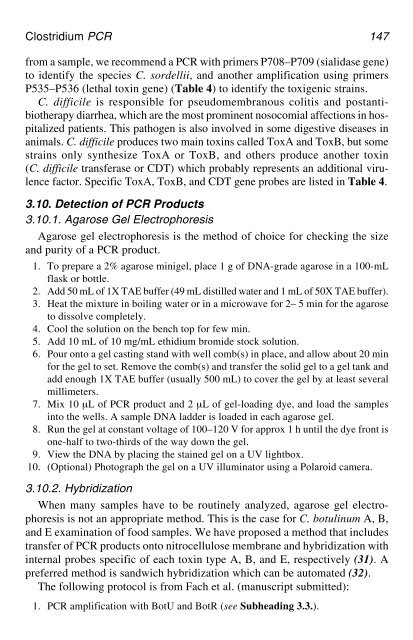PCR Detection of Microbial Pathogens PCR Detection of Microbial ...
PCR Detection of Microbial Pathogens PCR Detection of Microbial ...
PCR Detection of Microbial Pathogens PCR Detection of Microbial ...
Create successful ePaper yourself
Turn your PDF publications into a flip-book with our unique Google optimized e-Paper software.
Clostridium <strong>PCR</strong> 147<br />
from a sample, we recommend a <strong>PCR</strong> with primers P708–P709 (sialidase gene)<br />
to identify the species C. sordellii, and another amplification using primers<br />
P535–P536 (lethal toxin gene) (Table 4) to identify the toxigenic strains.<br />
C. difficile is responsible for pseudomembranous colitis and postantibiotherapy<br />
diarrhea, which are the most prominent nosocomial affections in hospitalized<br />
patients. This pathogen is also involved in some digestive diseases in<br />
animals. C. difficile produces two main toxins called ToxA and ToxB, but some<br />
strains only synthesize ToxA or ToxB, and others produce another toxin<br />
(C. difficile transferase or CDT) which probably represents an additional virulence<br />
factor. Specific ToxA, ToxB, and CDT gene probes are listed in Table 4.<br />
3.10. <strong>Detection</strong> <strong>of</strong> <strong>PCR</strong> Products<br />
3.10.1. Agarose Gel Electrophoresis<br />
Agarose gel electrophoresis is the method <strong>of</strong> choice for checking the size<br />
and purity <strong>of</strong> a <strong>PCR</strong> product.<br />
1. To prepare a 2% agarose minigel, place 1 g <strong>of</strong> DNA-grade agarose in a 100-mL<br />
flask or bottle.<br />
2. Add 50 mL <strong>of</strong> 1X TAE buffer (49 mL distilled water and 1 mL <strong>of</strong> 50X TAE buffer).<br />
3. Heat the mixture in boiling water or in a microwave for 2– 5 min for the agarose<br />
to dissolve completely.<br />
4. Cool the solution on the bench top for few min.<br />
5. Add 10 mL <strong>of</strong> 10 mg/mL ethidium bromide stock solution.<br />
6. Pour onto a gel casting stand with well comb(s) in place, and allow about 20 min<br />
for the gel to set. Remove the comb(s) and transfer the solid gel to a gel tank and<br />
add enough 1X TAE buffer (usually 500 mL) to cover the gel by at least several<br />
millimeters.<br />
7. Mix 10 µL <strong>of</strong> <strong>PCR</strong> product and 2 µL <strong>of</strong> gel-loading dye, and load the samples<br />
into the wells. A sample DNA ladder is loaded in each agarose gel.<br />
8. Run the gel at constant voltage <strong>of</strong> 100–120 V for approx 1 h until the dye front is<br />
one-half to two-thirds <strong>of</strong> the way down the gel.<br />
9. View the DNA by placing the stained gel on a UV lightbox.<br />
10. (Optional) Photograph the gel on a UV illuminator using a Polaroid camera.<br />
3.10.2. Hybridization<br />
When many samples have to be routinely analyzed, agarose gel electrophoresis<br />
is not an appropriate method. This is the case for C. botulinum A, B,<br />
and E examination <strong>of</strong> food samples. We have proposed a method that includes<br />
transfer <strong>of</strong> <strong>PCR</strong> products onto nitrocellulose membrane and hybridization with<br />
internal probes specific <strong>of</strong> each toxin type A, B, and E, respectively (31). A<br />
preferred method is sandwich hybridization which can be automated (32).<br />
The following protocol is from Fach et al. (manuscript submitted):<br />
1. <strong>PCR</strong> amplification with BotU and BotR (see Subheading 3.3.).






